
by Webb Pinner, Telepresence Lead
Kelley Elliott, Field Operations and Technology Specialist
July 9, 2010
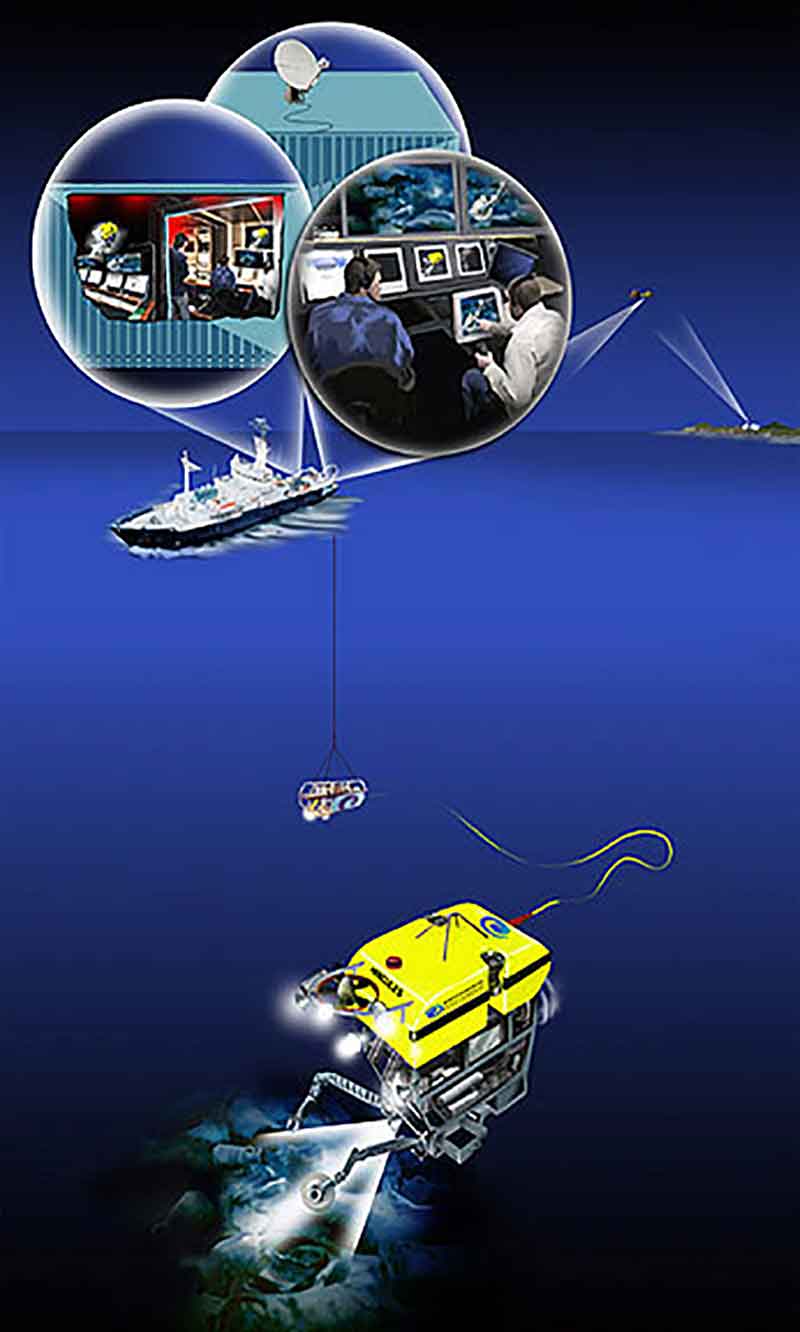
Telepresence uses satellite technology and Internet2 to transmit data and video in real-time from remotely operated vehicles working at depth to a shore-based hub at the University of Rhode Island's Inner Space Center, additional Exploration Command Centers around the country (and even in Jakarta, Indonesia), and a variety of other receiving stations on shore. Image courtesy of the NOAA Office of Ocean Exploration and Research, INDEX-SATAL 2010. Download image (jpg, 49 KB).
INDEX-SATAL 2010 marks the first time all of NOAA Ship Okeanos Explorer’s primary capabilities have come together with shore-side Exploration Command Centers (ECCs) to conduct systematic exploration. These systems include: an EM302 multibeam sonar bathymetric mapping system, recently tested to 7,800 meters water depth; a remotely operated vehicle (ROV) equipped with high-definition cameras and powerful underwater lighting and capable of descending to depths of 4,000 meters; and a telepresence system enabling real-time ship-to-shore communication with shore-based participants including the transmission of high-definition video, two-way voice communication, and large oceanographic datasets.
Implementing “telepresence,” or the real-time participation of geographically distributed participants, in a single event is far from simple. A variety of tools and technologies are being utilized aboard the Okeanos Explorer to facilitate this remote participation during the INDEX-SATAL 2010 expedition.
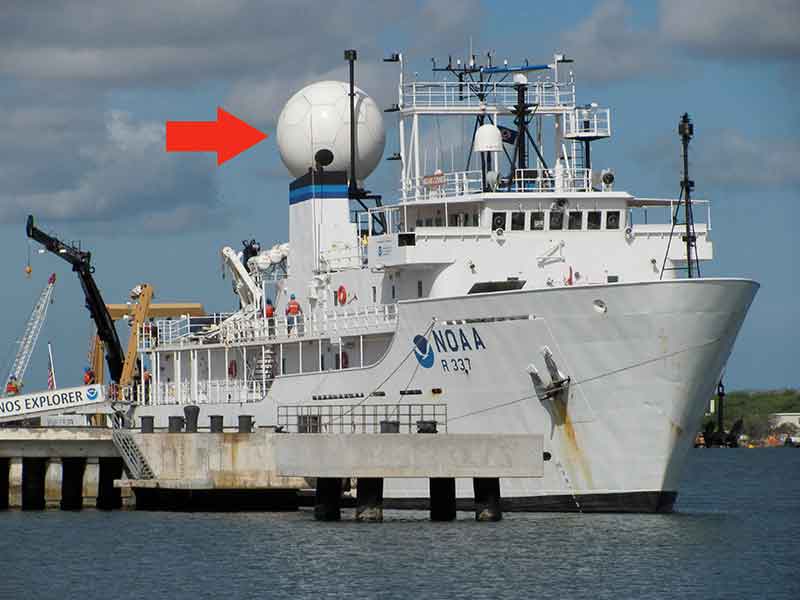
All communications with the shore are made possible by the Okeanos Explorer’s powerful satellite antenna. This antenna enables the Okeanos Explorer to establish high-bandwidth connectivity from remote parts of the world. This high-bandwidth connection allows the Okeanos Explorer to transmit three high-definition video feeds and establish real-time voice communication with the shore-based consoles and provides basic Internet connectivity for the ship’s personnel. Image courtesy of the NOAA Office of Ocean Exploration and Research, INDEX-SATAL 2010. Download larger version (jpg, 4.5 MB).
All communications with the shore are made possible by the Okeanos Explorer’s powerful satellite antenna. This antenna enables the Okeanos Explorer to establish high-bandwidth connectivity from remote parts of the world. This high-bandwidth connection allows the Okeanos Explorer to transmit three high-definition video feeds and establish real-time voice communication with the shore-based consoles and provides basic Internet connectivity for the ship’s personnel.
The Okeanos employs broadcast industry video encoders to deliver the high-definition video to shore-based viewers with the highest quality and lowest latency (time delay) possible. Despite the intensive encoding and decoding processes, the delays introduced by the satellite link and land-based links, the video travels from the ROV at depths as deep as 4,000 meters to the ECCs in an average of 6 seconds.
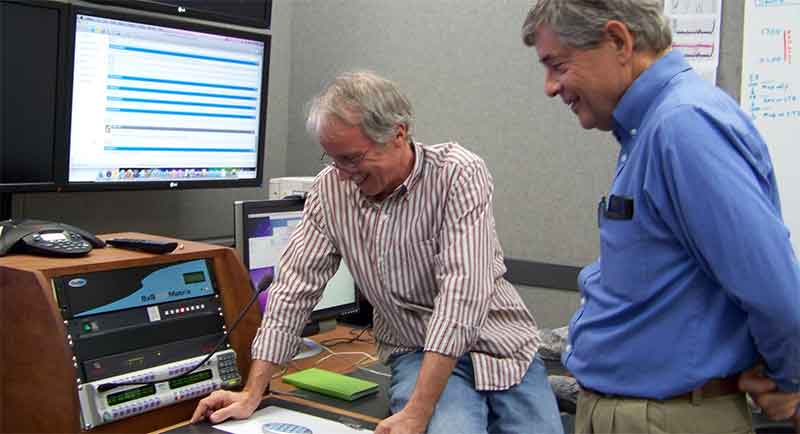
Voice communication between Okeanos Explorer and shore-side ECC’s uses another technology borrowed from the broadcast industry, an IP-enabled intercom system. The intercom system leverages the Okeanos Explorer’s Internet connectivity to connect all of the ship-based and shore-based intercom units into a single system. This allows all participants, regardless of location, to easily communicate with all other participants. Here, scientists at the Seattle ECC communicate with participants on the ship and at the Jakarta ECC. Image courtesy of the NOAA Office of Ocean Exploration and Research, INDEX-SATAL 2010. Download larger version (jpg, 2.1 MB).
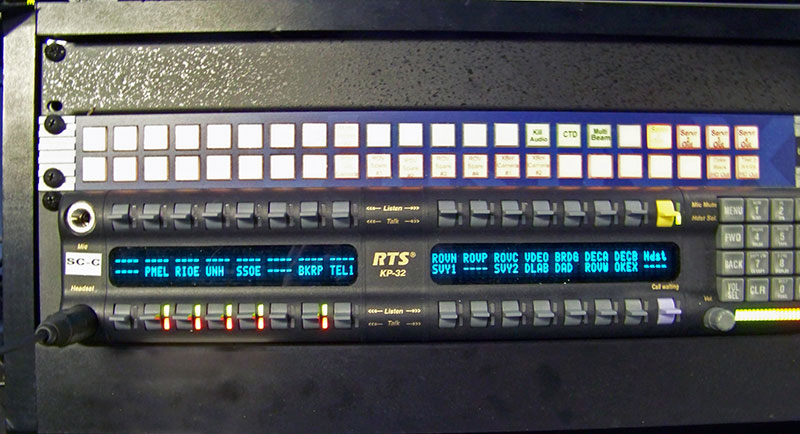
A close-up view of an RTS unit in Okeanos Explorer’s control room. The RTS units use an IP-enabled intercom system, leveraging the Okeanos Explorer’s Internet connectivity to connect all of the ship-based and shore-based intercom units into a single system. Image courtesy of the NOAA Office of Ocean Exploration and Research, INDEX-SATAL 2010. Download larger version (jpg, 2.0 MB).
Voice communication between the Okeanos Explorer and shore-side ECC’s uses another technology borrowed from the broadcast industry, an IP-enabled intercom system. The intercom system leverages the Okeanos Explorer’s Internet connectivity to connect all of the ship-based and shore-based intercom units into a single system. This allows all participants, regardless of location, to easily communicate with all other participants.
The real-time voice communication is supplemented by a real-time text-based collaboration tool. This text-based tool, commonly referred to as the “Eventlog,” allows ship-based and shore-based participants to write their observations to a common log. The log entries made by individuals are immediately disseminated to all other users in real time, allowing all participants, regardless of location, to see the observations made by their peers. All users on the ship and at the ECCs are encouraged to participate in the Eventlog, as everyone may be able to provide a unique observation and insight.
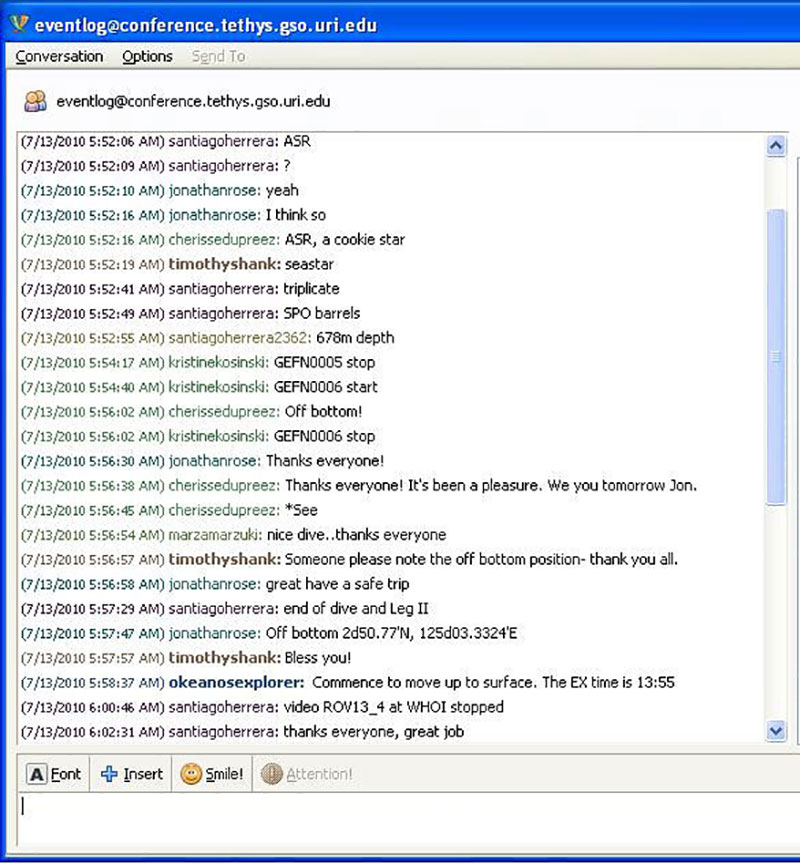
INDEX-SATAL 2010 participants are using a real-time text-based collaboration tool called the “Eventlog” to communicate and make log entries about ongoing operations. The log entries made by individuals are immediately disseminated to all other users in real time, allowing all participants, regardless of location, to see the observations made by their peers. The Eventlog tool leverages the same technology and standards-based protocols used on the Internet for instant messages (IM) and chatrooms. Image courtesy of the NOAA Office of Ocean Exploration and Research, INDEX-SATAL 2010. Download image (jpg, 142 KB).
To help with the post-cruise analysis, each log entry includes the date and time the entry was made, the author and the text observation. The date and time matches the date and time used aboard the Okeanos Explorer. This simplifies post-cruise data and video searches. The Eventlog tool leverages the same technology and standards-based protocols used on the Internet for instant messages (IM) and chatrooms. This standards-based approach simplified the development and deployment of the system.
The ability to watch the live events aboard the Okeanos Explorer is not limited to those with access to an ECC. The Okeanos Explorer distributes the video streams over a U.S.-based next-generation academic network called Internet2. Internet2 employs advanced computer networking technologies that allow an increasing number users around the globe to simultaneously view the live video. Since the inception of Internet2, other countries have developed their own advanced academic networks and today most of those networks are interconnected to form a global network.
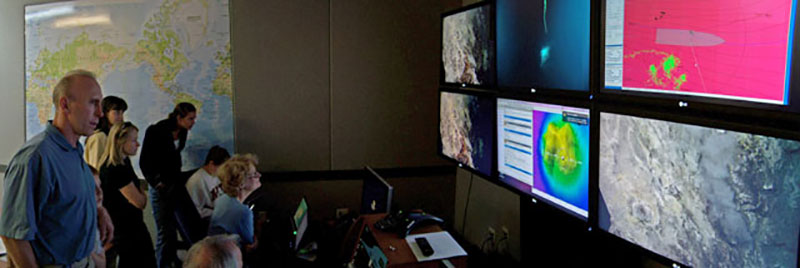
The impact of telepresence is marvelous: 10-20 scientists and thousands of public onlookers from three countries and five time zones and distributed across thousands of miles are able witness, discuss, and document the incredible life and habitats persisting at the bottom of an Indonesian Sea. Here, participants marvel at imagery sent from the bottom of the Indonesian Sea to monitors at the Seattle ECC. Image courtesy of the NOAA Office of Ocean Exploration and Research, INDEX-SATAL 2010. Download image (jpg, 49 KB).
Initially, only computers connected to this advanced network were able to view the streams, but as the excitement built up around the Okeanos Explorer and the INDEX-SATAL 2010 expedition, participants began using increasingly creative solutions for developing ad hoc viewing stations, and in some cases, mini-ECCs utilizing the standard Internet. These solutions extended telepresence capabilities to smaller academic institutions, public venues, hotel rooms, the cafeteria at the U.S. Embassy in Jakarta, and even at one scientist’s private residence.
The impact of the live ship-to-shore video feeds, the real-time two-way voice communication, and the widespread participation with the Eventlog is marvelous: 10-20 scientists and thousands of public onlookers from three countries and five time zones and distributed across thousands of miles are able witness, discuss, and document the incredible life and habitats persisting at the bottom of the Indonesian Sea.